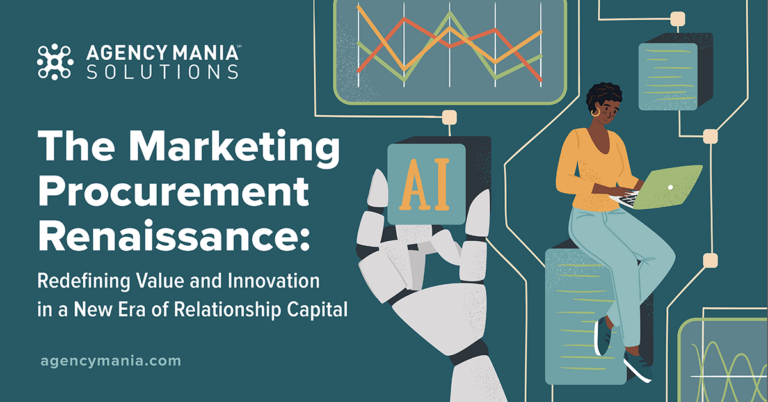Improving the output of client–agency collaboration to drive cost efficiencies and bulletproof your business in turbulent times.
In the cacophony of business life and a new year full of promises, when the demands of work, team commitments, and the ever-present allure of conflicting priorities create a symphony of chaos, the quest to get things done becomes a virtuoso performance of its own. Managing agency relationships to unleash the greatest value and performance is no walk in the park, especially in this economic environment. Brand advertisers face budget pressure, greater demands, and higher expectations. Everyone is asking for a greater output at a lower cost, even when financial and human resources are scarce. The agency relationship takes nurturing and a unique appreciation for what each party brings to the table. It takes practice, rigor, and diligence. Brand advertisers do not have the luxury of operating in a manual, wasteful, labor-intensive world where decisions are ill-informed or lacking data to back them up.
In this article, we embark on a journey through the labyrinth of partnership building, armed with a conductor’s baton of clever strategies, proven tactics, and harmonious approaches. As a client, prepare to be both the composer and the conductor in handling your agency relationships as we turn this chaos into a crescendo of joint success. Simply put, it’s about getting things done the right way. Thankfully, many tools/capabilities are available to turn agency relationships into value-added partnerships. These capabilities include rigorous scope of work and fee negotiations; regular, insight-rich client–agency evaluations; and streamlined production fee and bidding management practices. Let’s take a closer look at some of these tools and best practices:

S – Smart Scope of Work Management
Gartner’s CMO Leadership Vision eBook states that the top 2024 priorities for chief marketing officers are threefold: build AI-enabled marketing teams, recast marketing’s value for an evolving enterprise, and orchestrate profitable growth across functions. One thing the eBook doesn’t provide is a road map of best practices to get there.
In order to achieve the priorities stated above, institute a more rigorous, fact-based, benchmark-enabled process to define marketing initiatives and tactics to meet organizational goals. Next, negotiate a reasonable fee for the agency resources required to carry it through. This is what automated scope of management systems do. For CMOs to be successful in 2024, it’s imperative that they empower their staff to use a consistent, simplified, streamlined scope of work and fee management system. This replaces the typical Word documents, endless email chains, and time-wasting, confusing, subjective, error-prone, old-school processes. Marketers and procurement teams must be equipped with cutting-edge capabilities to best define requirements and align with expectations, while also maintaining fiscal accountability with agency partners. How could the CMO, in good conscious, speak to the CEO or board of directors about bleeding-edge AI innovation while quietly relying on an archaic, manual process to manage one of the company’s largest expenses? If you want to get things done right, operationalize and automate your scope of work management.
T – Thorough Performance Assessments
Marketing leaders need all their resources – internally and externally – to work in concert to deliver on their organizational goals. The importance of measuring the performance of talent cannot be overstated. Just as a conductor relies on specific instruments to orchestrate a symphony, businesses and organizations need reliable metrics to gauge the effectiveness and contributions of their human capital. Performance measurement provides a tangible assessment of an agency or a specific team’s accomplishments while serving as a compass for improvement and growth.
Most brands conduct biannual client–agency performance assessments (at mid-year and year-end) to strengthen the partnership by identifying opportunities to course-correct and improve the relationship. Agencies are high-touch partners that require special handling and collaboration. A performance assessment acts as a strategic tool for organizations to align their objectives with the skills and capabilities of their workforce, fostering a culture of continuous learning and development. By quantifying achievements and identifying areas for enhancement, performance measurement becomes the cornerstone of informed decision-making. It helps ensure that agency or internal talent is not just recognized but also harnessed to their fullest potential. In essence, performance assessment transforms the abstract notion of talent into a measurable force that propels individuals and organizations toward sustained success. If you want to get things done right, institute a biannual performance assessment process to drive actionable insight that improves the relationship and its output.
U – Unbiased KPIs
Edwards Deming said, “Without data, you’re just another person with an opinion.” We know all too well that marketers have a lot of opinions. Although instinct is an important marketing quality, relying on tangible, proven metrics is the most effective way to move at high speed without crashing. Metrics serve as guideposts for marketers, offering insights into the effectiveness of campaigns and efforts in shaping marketing strategies.
Accurate and relevant metrics not only quantify the return on investment but also offer a comprehensive understanding of behavior, engagement levels, and overall trends in the work or relationship with the agency partner. With the right metrics in place, brands can make informed decisions, improve performance, and allocate resources more effectively. As it relates to client–agency relationships, besides performance assessment KPIs, there are several other highly valuable KPIs that brands should consider for steering their relationships in the right direction. In “media” for example, it’s not uncommon for agencies to be compensated based on their performance, even partially. Performance is often based on a basket of KPIs, ranging from qualitative media KPIs (like placement quality) to quantitative financial, business, and marketing metrics, such as revenue, share of voice, brand equity, or lead conversions. KPIs can also be operational metrics related to the work itself; for example, the number of creative revisions or the agency’s ability to deliver a project on time and on budget. KPIs can be accessed in a timely manner through interactive dashboards and other business intelligence tools. For effective decision-making, make sure to rely on sound KPIs – they serve as a reliable guide for getting things done right.
FF – Full-length, Fundamental Agency Roster
In conversations with marketing leaders, I am often surprised by how challenging it is for them to have an accurate view into their agency roster and how hard it is for their marketers to find the right partners for a given project. They tend to work with a few carefully selected agencies and then engage them on a regular basis. Yet, as the 80/20 rule implies, as much as a quarter of their budget is spent on three-fourths of their supplier base. It is often referred to as the “long tail.” If you work or have worked for a large brand, you know how difficult it is to mandate the use of agencies or restrict access to an ever-growing pool of dynamic agencies, hopefully approved but often rogue and outside of corporate mandates.
In today’s economic times, it is simply unthinkable to have such a large portion of marketing spend under-optimized or under-leveraged. Particularly when a company could easily realize economies of scale and reduce the inherent risks associated with small, unproven partners that may not have received formal onboarding. There is a better way.
Many brands now offer a single destination, a sort of portal, to marketing teams. It’s an easily searchable database of approved agencies organized based on skill sets and approved capabilities. The database is populated with rich profiles (e.g., historical work and performance ratings, agency reels, work examples, talent, and key contacts). The detailed profiles allow marketers to pick the right agency based on vetted qualifications. Having a trusted place to go and finding a quality partner can save tremendous time and effort, reduce frustration, and, even better, help prevent failures down the road. If you want to get things done right, provide your marketing teams with an easy-to-search, comprehensive roster of approved agencies.
French emperor and military strategist Napoleon Bonaparte proclaimed, “A revolution is an idea, taken up by bayonets.” Ideas alone won’t drive meaningful change. With the potential to become a symphony of efficiency, getting things done the right way is not so hard after all. Brand advertisers and their leadership teams need the means to bring those ambitions to life. They need to provide marketers with the tools to be effective at what they do and partner successfully with their agencies. If you harmonize the right scope of work management system with a high-touch performance assessment, the right KPIs, and a robust agency roster, you and your marketing organization will have all you need to get STUFF done better, faster, cheaper, and smarter.
By Bruno Gralpois
Author/Speaker, Thought-provocateur, Client/Agency Guru, Entrepreneur, Innovator








